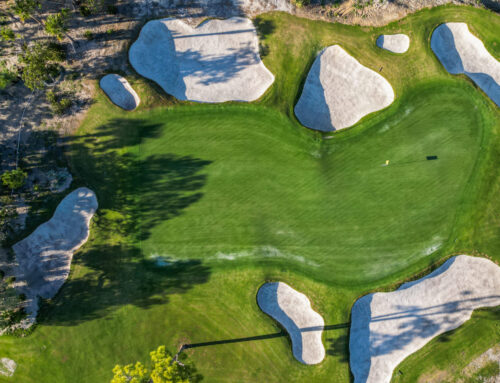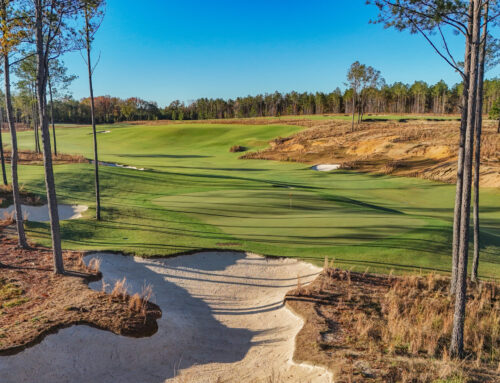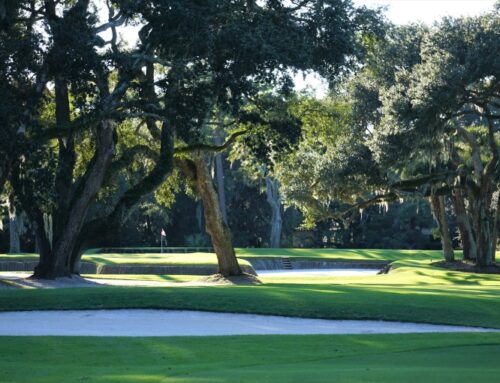The Golf Courses at Lawsonia (Links Course)
Wisconsin, United States of America

A game of golf on the Links Course at Lawsonia is one of the most fun chess matches a golfer will ever have with an architect. The greedy golfer above pays the price for trying to lay up to close to the par five 11th green.
Even more so than Stiles and Van Kleek, Langford & Moreau deserve consideration as the finest, least known architect team of all-time.
Unfortunately, not enough is known about them with the possible exception beingRon Whitten, who notes in his Feature Interview on this site that he has accumulated one hundred old Langford blueprints. With over 200 courses to their credit (most of which are in the midwest), they were more prolific than many realize, including such gems as the nine holer at Harrison Hills in Indiana, their impressive re-work of Skokie CC in Illinois and Wakonda in Iowa.
William Langford and Theodore Moreau formed their design partnership in Chicago in 1918 and one wonders what influence Macdonald’s early version of Chicago Golf Club followed by Raynor’s 1922 re-work (right when Langford & Moreau became busy) must have had on this pair. In addition, golf architecture historian and writer Tom MacWood conjectures that Langford frequented National Golf Links of America before graduating from Yale in 1908 as well as later at Columbia where he received his Masters. MacWood reasons that such visits to NGLA, Piping Rock and perhaps Sleepy Hollow would have surely shaped Langford’s design philosophy.
And there are definite similarities between the work of Langford & Moreau (who was a civil engineer) and Macdonald and Seth Raynor (who had a civil engineering degree as well). Langford & Moreau’s courses have a somewhat engineered look, though less so than Raynor’s solo efforts. Like Raynor, they moved plenty of dirt to build up their green complexes yet seemingly moved little dirt elsewhere other than for bunker construction and tee boxes. They didn’t shy away from bold interior green contours of the sort where C.B. Macdonald assisted Raynor such as at Yale Golf Club. Another great attribute that they shared with Macdonald/Raynor was their ability to find the routing that yielded the most pleasing holes. And finally and perhaps most importantly, like Macdonald/Raynor, a primary focus of theirs was on the strategic merit of a course.
In The Golden Age of Golf Design, Geoff Shackelford quotes William Langford as follows: ‘Hazards should not be built solely with the idea of penalizing bad play, but with the object of encouraging thoughtful golf and of rewarding the player who possesses the ability to play a variety of strokes with each club.’ Shackelford goes on to provide examples of Langford’s love of alternate route holes, again highlighting the importance that Langford placed on strategy.

Strategy abounds at Lawsonia. Right away at the 1st, if the golfer stays toward the inside of the dogleg right, then the steep slope left of the green isn’t as likely to factor into his approach.
Victor Lawson’s farm land property that Langford & Moreau walked was treeless, open to the winds and featured nice changes in elevation (all pluses) but many of the slopes are broad in nature, which can be problematic for an architect. Yet, upon playing the course, one appreciates the golf quality in each and every hole, a sure sign in part of a superb routing.
One way in which they achieved so many remarkable holes from this site is that they didn’t dwell excessively on the par of the holes by stamping out the norm of four one shotters, four three shotters and ten two shotters. Rather, the scorecard reflects five par threes, five par fives, and eight par fours. Indeed from the 9th hole through the 14th, par is 5-3-5-3-5-3, which few architects (or owners) would have the conviction to do today. Yet, can anyone imagine a better set of holes over that portion of the property? The author can’t.
In the context of a superb routing, the golfer is reminded of another public golf course of the highest quality – the Black Course at Bethpage. Yet, unlike Bethpage, the Links Course at under 6,800 yards doesn’t rely on length to provide its challenge and is far more interesting from forty yards and in than the Black Course ever was.
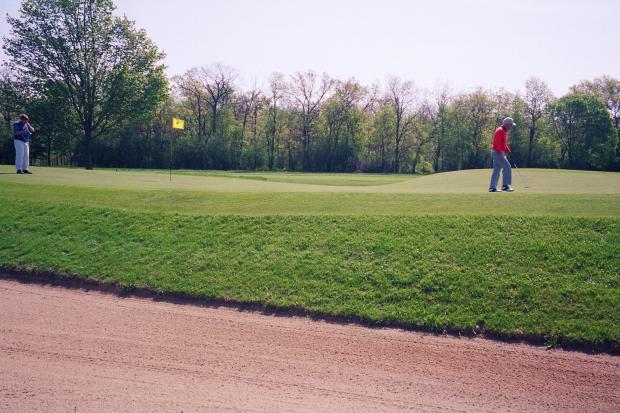
Set in the middle of a field, the best way to give the one shot 12th character was through wild interior green contours and that’s exactly what Langford & Moreau did. By so doing, no extraneous dirt was moved.
Holes to Note
2nd hole, 430 yards; Langford & Moreau cut deep left and right cross bunkers into the crest of the hill 130 yards from the 2nd tee. Though not a great feat to carry them, the sight of a well hit tee ball sailing over them is a pleasing one for golfers of all levels. Some would argue that such hazards only penalize the weak golfer but imagine the view from the tee without them, and the author thinks that the hole is all the better/more satisfying for them.

A picture of the left cross bunker at the crest of the hill.

Langford & Moreau frequently employed grass mounds or bunkers 20-60 yards short of greens. When the Lawsonia opened, such hazards were a real threat as players played a low game along the ground. Today, such features create depth perception problems for the better player while giving the weaker player something to accomplish as well.
3rd hole, 385 yards; Another in what becomes a long line of strategic golf holes, a bunker with a six foot high grass face dominates the inside of this dogleg to the right. The more the golfer flirts with it off the tee, the easier his approach.

The 3rd fairway doglegs right around this well placed bunker at the 250 yard mark from the tee.
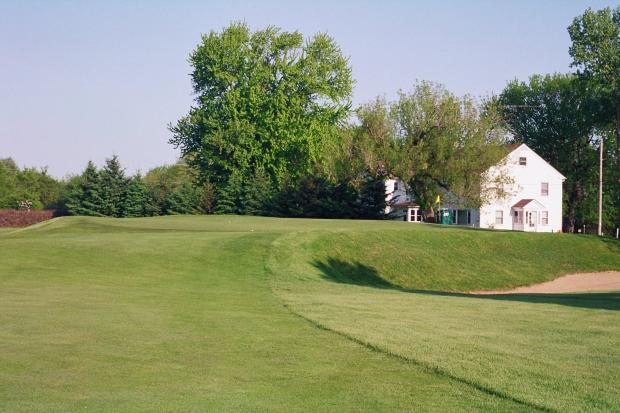
The elevated 3rd green is open front left and falls toward the back right. A low running approach tracks to this back right hole location.
5th hole, 485 yards; A wonderful gambling hole where a big tee ball either a) brings the green within reach in two or b) brings the out of bounds right or trees left into play. This is the tightest driving hole on the course and some may elect to leave the driver in the bag.
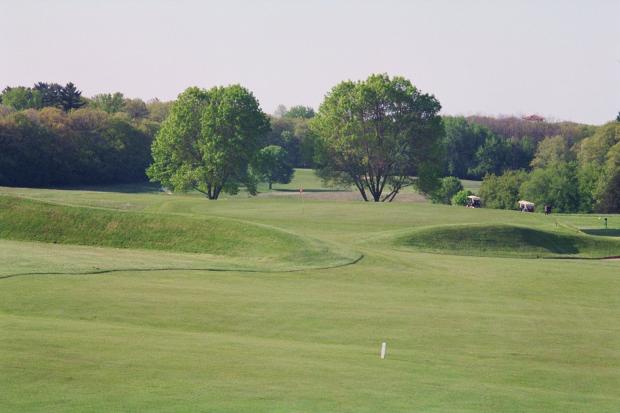
The view after a good drive, with the 5th green now in reach in two.

Given that the approach for those going for the green in two is often from a hanging lie, this bunker thirty yards shy of the 5th green gathers plenty of mishits and from there, a par becomes uncertain.
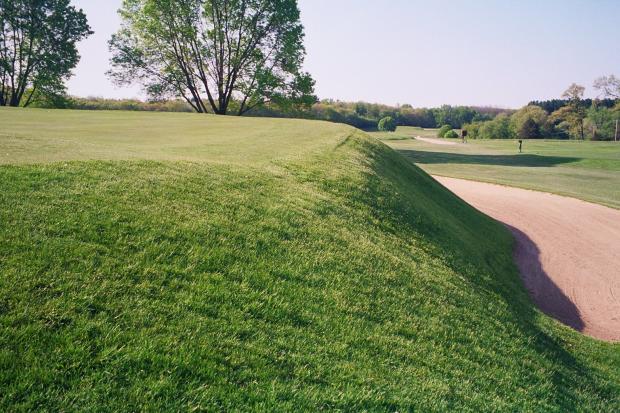
The 5th green falls away to a back right bowl. When the hole is located in this vexing position, the player should have his approach run down into it from the middle of the green. Flying the approach into the back bowl is foolhardy as the price for a miss is dear, as seen above.
6th hole, 440 yards; For many, this is their favorite hole in Wisconsin.
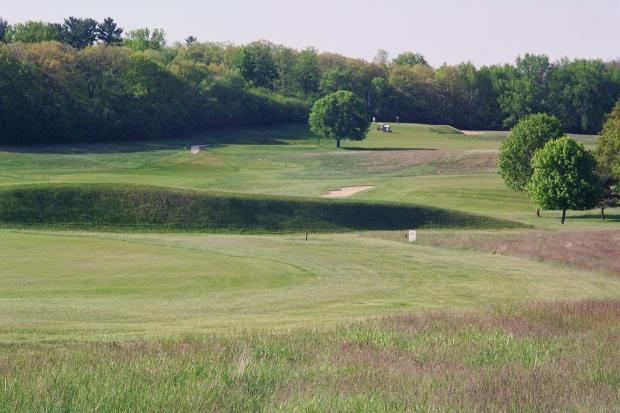
The tee ball must carry 200 yards to clear the huge grass mound that dominates off the tee while at…
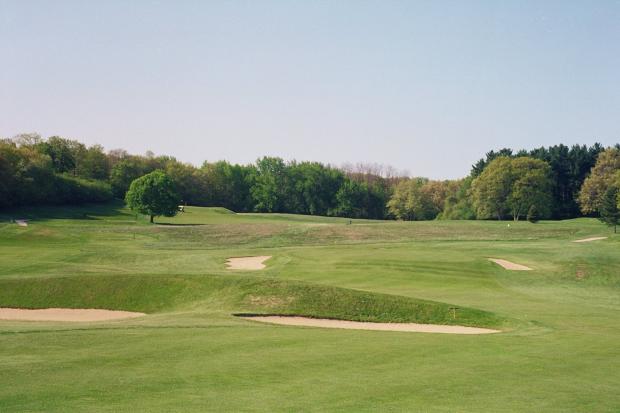
…the same time, stay short or to the right of this pair of blind bunkers that are 300 yards from the tee.
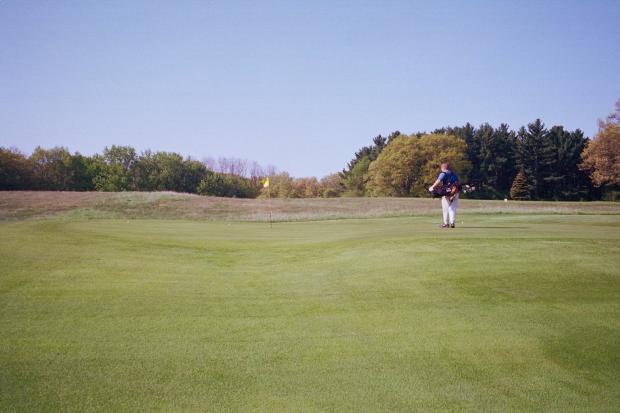
The wild 6th green features a two foot spin through its left middle.
7th hole, 160 yards; With a box car allegedly buried beneath the elevated green, Lawsonia’s most famous hole is truly a well defended Short hole.
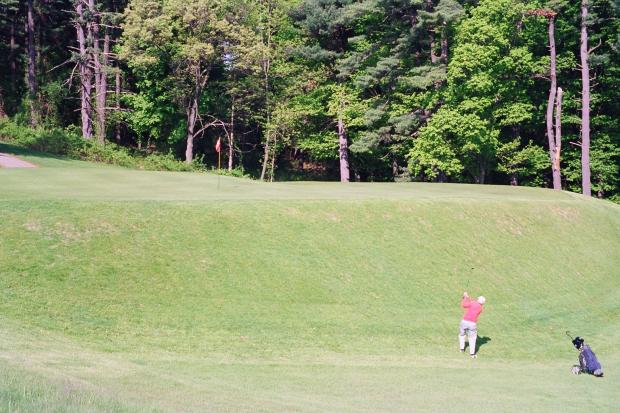
This tee ball hit a few feet short of the 7th green’s front edge before rolling down fifteen feet to the mound’s base.
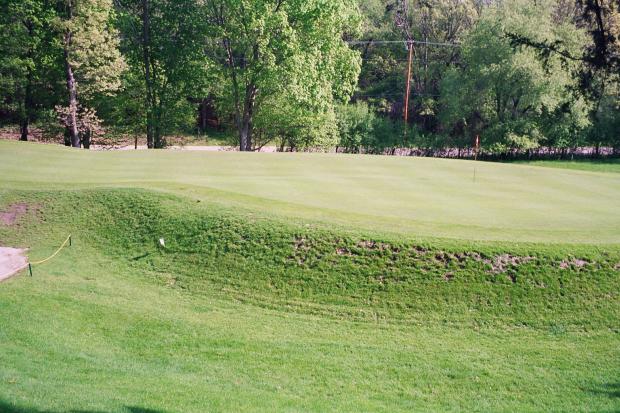
Having seen the ball roll down to the base, another golfer in the group hit an extra club, only to find the five foot deep grassy hollow to the left of the green. From there, a four was a good score as the green slopes away from left to right.
8th hole, 340 yards; Much improved thanks to a recent tree removal program, the golfer is now tempted to drive toward the 8th flag, which is visible from the tee. All that does is put the golfer in the fescue rough with a miserable lie/angle across a moat bunker to the green. The trees that were down the right made the hole easier as they steered the golferalong the correct line from the tee, which is to say straightahead.
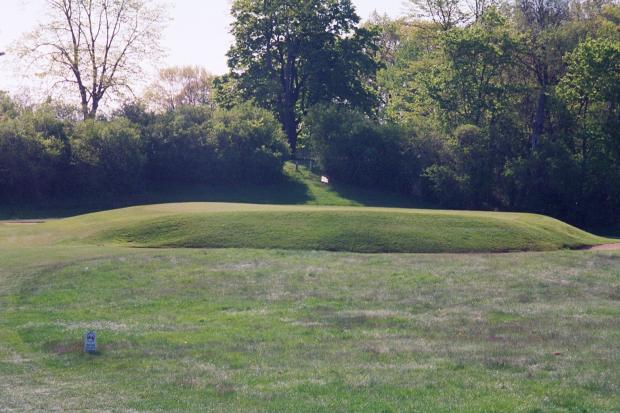
The golfer on the 8th tee needs to resist going directly at the green as nothing good will happen.
10th hole, 240 yards; After playing the inspiring front, the golfer might be excused for thinking that the back is bound to be a let down but the tenth dispells that notion.

This bunker 60 yards short of the 10th green makes the golfer want to cheat to the left and as a result…
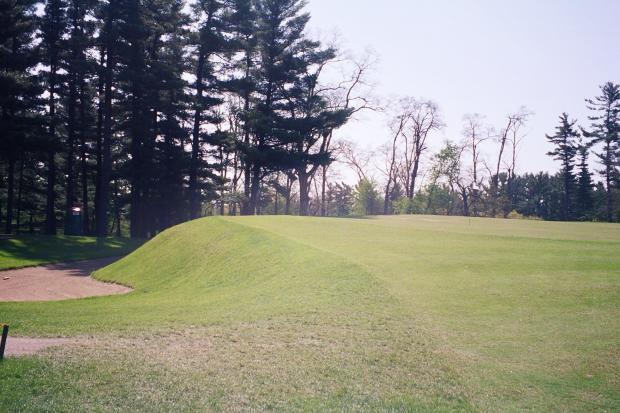
…the seven foot deep left greenside bunker gets plenty of play.
13th hole, 570 yards; With the natural tilt in the fairway fromright to left, the golfercan play well wide of the staggered diagonal bunkersin theleft of the fairway (to land in them makes reaching the green in three problematic given their tall grass faces). Often into the wind, the golfer really has to bust his second to get past a gully and be on the upslope of the same hill where the green sits. Otherwise, his approach is blind. All in all, a unique hole.

The first task at the 13th is to pass these diagonal bunkers on the right.
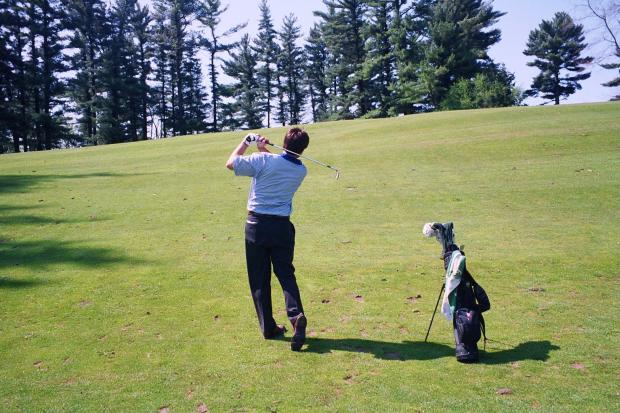
When played into the prevailing wind, the third shot into the 13th is often blind from the base of a gully which runs 90 to 120 yards shy of the hilltop green.
14th hole, 155 yards; After transitioning into the evergreens while playing the approach into the 13th green, the one shot 14th stays within the same forest, which gives this one shotter an altogether different feel from the other four par threes. Like the 14th at Pine Valley, these mature trees didn’t exist when the architects were there and if anything, they comfort the golfer into making a better swing, in part at least because the effects of the wind are diminished. Old pictures of the stark 14th green complex are more terrifying but few will deny that today’s hole is visually beautiful.
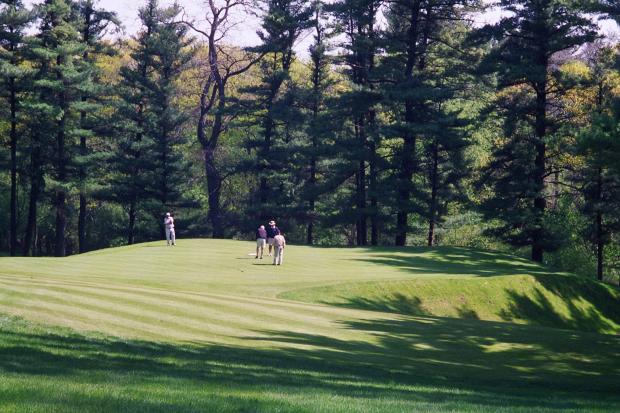
The inviting one shot 14th – where the architects got the dirt to build up this green is a mystery but where there is a built-up Langford & Moreau green, there is generally a deep bunker. In this case, it’s diagonally across the right of the green.
16th yards, 445 yards; Played up a broad slope, this lengthy hole could feel like a long slog. However, it doesn’t as the golfer never sees more than 170-200 yards up the fairway, first because of a pair of cross bunkers off the tee and then a dominant bunker that juts into the fairway from the right 60 yards shy of the 16th green.

The view from the 16th tee. As with the cross bunkers at the 2nd, the golfer learns to use the grass faces for alignment off the tee, with the ideal line in this case being over the right edge of the left mound.

If the golfer is gummed up off the tee, getting past this bunker 60 yards shy of the 16th green can prove a challenge.
17th hole, 385 yards; Not set over one of themore interesting parts of the property, Langford & Moreau nonetheless created a hole of genuine merit. Their ability to create something from nothing helps make their designs of such high standard.
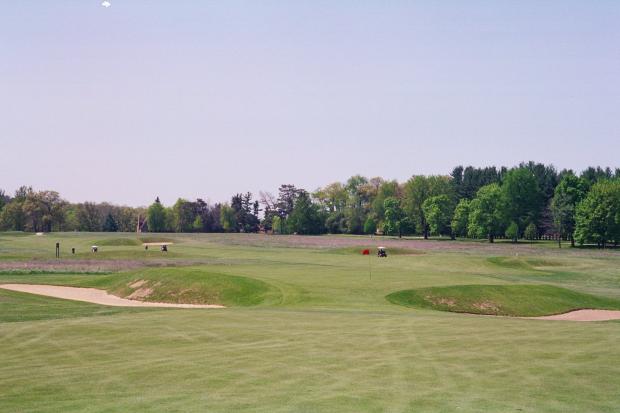
The pushed up 17th green creates an exacting target, especially when the wind is about.
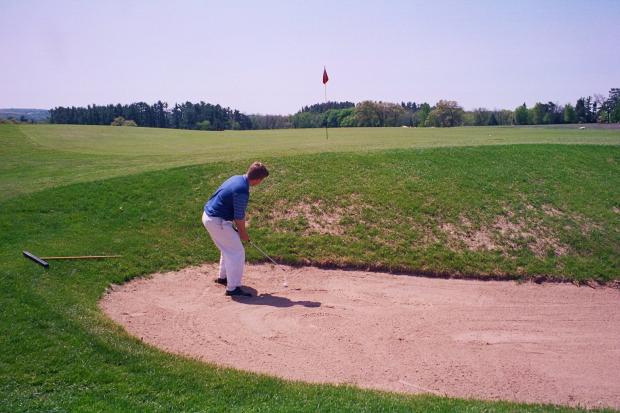
No easy recovery from the greenside bunkers at the 17th.
18th hole, 505 yards; One of the author’s favorite Home holes in golf, any number of swings of fortune can occur, from an eagle to a triple. As with every tee shot at Lawsonia save for the 5th, the golfer is encouraged to make a big, positive swing off the tee as there is plenty of width in the hitting area. As with almost every Golden Age architect, Langford & Moreau defend par up toward the green and each shot gets progressively trickier.
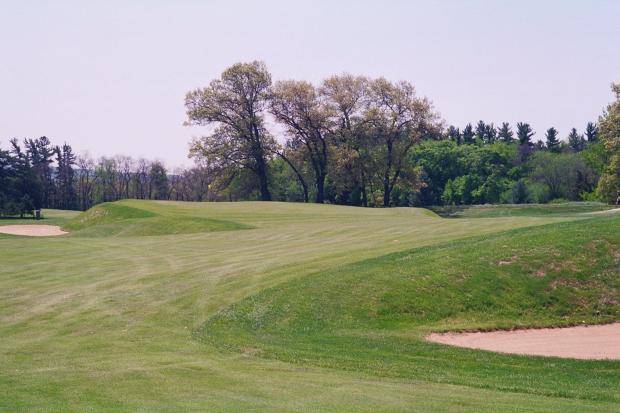
A draw from 240 yards out that avoids the bunker in the foreground and…

…stays right of these two pits left of the green makes for a thrilling finish.
From a 1930 article that MacWood found written in The National Greenkeeper:
The Lawsonia Country Club at Green Lake, Wisconsin dedicated its new $250,000 golf course on May 30 with a tournament….The eighteen-hole course was laid out in 1928 and completed in the spring of 1929, but it was not played on last year. Langford & Moreau of Chicago, noted golf architects, who have built many of the outstanding courses in this country, designed the Lawsonia course, which is of championship caliber and a real test of golf. The new Lawsonia course is of the most part on high and rolling ground, although in places the high terrain dips into secluded woodland nooks, where the forestation program of the late Victor Lawson, whose country estate Lawsonia was before it became a country club, has come to rich fruition. Thus there was given to the golf architect a perfect combination of open highland and wooded valley to develop into a course, which is not only exacting but an ever present interesting natural beauty. Many delightful views of Green Lake and the other waters of the surrounding countryside are offered to the player as well as glimpses of the club house and gardens of Lawsonia.
The discontinued yardage book modestly notes that the Links Course ‘has reserved a spot on lists of the nation’s top 100 public golf courses.’ Don’t be fooled by that – this course is far and away more engaging to play than most public, private or resort courses.
The End



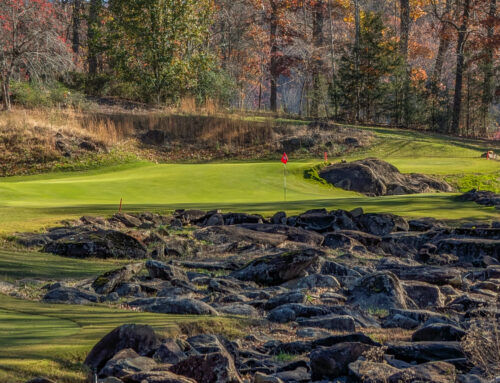
![The Park, West Palm (Lit 9) [2023]](https://golfclubatlas.com/wp-content/uploads/2024/12/IMG_7092-2-scaled-500x383.jpg)
